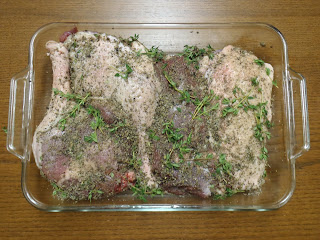
You'll also need one goose. This one is from Greens, Eggs, and Ham, and weighs about eleven pounds.

Only the breasts and thighs and legs are used for confit.

Rub the spices onto the goose pieces. Place the meat in a non-reactive container, cover, and refrigerate for two days.

Interlude: Rendering the Fat
Confit requires a lot of fat. The exact amount depends on the size of your cooking vessel and how tightly you can place the meat within. Expect to use about three quarts.
Even though the choice fat around the breasts and legs is going into our confit, there is still lots of fat to be rendered from the goose. Look for fatty trim around the neck and the opening of the cavity. There will not be enough fat from this one bird to make the confit; you'll have to supplement with fat from another source.

Put this trim in a stainless steel pot with a quarter cup of water. The water helps to evenly distribute the heat. It will slowly evaporate, but by the time it's gone there will be sufficient liquid fat to take over the role of heat distribution.
Set the pot over very low heat. After several hours there should be clear liquid fat, and crispy pieces of skin called cracklings that can be reserved to flavour stocks and braises. Strain the liquid, which will settle into two distinct layers. The top is the fat, and the bottom is essentially a highly reduced stock. The stock can be used, but lacking the support of mirepoix and herbs, it won't have much depth of flavour. If you leave the mixture at room temperature, the stock, being high in gelatin, will solidify, while the fat will stay liquid. At this point you can simply decant the fat.

Cooking
After two days, rinse all the spices from the goose pieces. Dry the meat thoroughly with paper towels.
Heat the goose, duck, or pork fat (or some combination thereof...) until just liquid. Pour over the meat. Again, the meat must be completely submerged.

Cover the cooking vessel and place in a 180F oven. This can be tricky in home kitchens, becuase even though the lowest setting on the dial might be 150F, ovens routinely lie to their owners. Our oven, for example, usually runs 50F-100F hotter than the dial setting. This doesn't affect the outcome of most home-cooking, but it can most certainly taint a batch of confit.
Water boils at 212F. By making confit at 180F, we coagulate the proteins and break down connective tissue without boiling off any of the moisture. The result is an impossibly moist piece of meat. Invest $20 in a good oven thermometer to ensure your cooking temperature stays below 212F.
Cooking times for confit are long, usually eight to ten hours. I leave mine overnight (hence the dismal lighting in some of these pictures).
After cooking, the meat will be tender and the fat will be clear. If your meat is bubbling under the fat, then your oven was too hot. You can still use the meat, it just won't be as moist as it should be.

Let the meat cool in its cooking vessel, still submerged in the fat. It can be stored in the fridge for up to a month.
To use the confit, let the vessel come to room temperature, then dig out the meat and wipe off the excess fat.
Goose Rillettes
Remove the skin from the goose pieces. Pull the flesh apart with two forks.

Mix the pulled meat, slowly adding some of the cooking fat. The pieces of meat will start to come together and form a coarse paste.


Pack the paste into ramekins so that there are no air pockets. Refrigerate to set. Pour some of the cooking fat over the surface. This sealing process was traditionally done to help preserve the rillette. The meat should be submerged by about 1/8" of fat.

Eat with toast. I don't know why, but plain bread doesn't work. It must be toast.




another delicious thing is cretons !
ReplyDeleteI hope you and lisa will try it on toast, it's super delicious on toast !
http://en.wikipedia.org/wiki/Cretons
Hey Michelle! Fancy meeting you here...
ReplyDeleteIt just so happens that we made cretons this past Christmas. I even wrote a post about it: here's the link.
How did you come across cretons? Did you have them in Quebec?
I LOVE cretons !! HORRAH
ReplyDeleteYes, I first had it in Quebec (it was super delicious) and then at a place I volunteer, a lady was originally from Quebec and she made her 'own version' of it, which was also quite delicious !